- Home
- Bill Bryson
The Road to Little Dribbling Page 23
The Road to Little Dribbling Read online
Page 23
I spent the night in Woodstock and in the morning rode a smart and stylish bus to Oxford. The bus was very blue inside and out, and very clean, too. This was the bus I had expected on my journey from Bognor to Hove. The seats were exceedingly comfy, in a deep blue leatherette finish. I sat upstairs and enjoyed the views. The bus was popular, though not nearly as popular as the private car. All roads into Oxford were clogged with traffic – backed up at roundabouts, queuing at petrol stations, creeping into town in barely moving lines. I don’t mean to bang on, but am I the only one to wonder if the best solution to Oxford’s problems is to make it more suburban?
Oxford is a victim of its own attractiveness. More people want to live there than it can comfortably accommodate, and you can’t blame them. Traffic aside, I am prepared to nominate Oxford as the most improved city in Britain. In Notes from a Small Island, I was hard on the dear old place, not because it was especially bad but because it wasn’t good enough. My feeling is that certain places that are beautiful and historic – Oxford, Cambridge, Bath, Edinburgh, to name four – have a particular duty to remain so, and Oxford for quite a long time didn’t seem to understand that.
Well, how that has changed. New buildings have been going up all over, some of them very striking. The High Street has been closed to through traffic, so is much more agreeable to stroll along, and it has some smart shops and restaurants and a stylish hotel. Millions have been lavished on improving the university’s peerless stock of museums, particularly the Ashmolean. Just outside the railway station, some grand new scheme was being developed. At the time I passed it seemed to be concentrating on taking down healthy-looking trees and disrupting traffic, but I trust those are both shortcomings that will be fixed. The idea, I gather, is to provide Oxford with a grand new concourse to welcome people emerging from the giant bike rack that is its station, which can only be a good thing. When I came to Oxford in 1995 for my book, I was particularly scathing about the Merton College Warden’s Lodgings, which I believe I likened to an electrical substation. Well, a couple of years ago they rebuilt the lodgings in a more discreet and sensitive style. Now it is a thing of quiet beauty, modern but respectful, and in perfect harmony with the medieval street on which it stands. Sir Martin Taylor, the kindly warden (which is to say head of the college), invited me to cut the ribbon at a small ceremony. It may have been the proudest moment of my life. I walked up Merton Street now and looked at the lodgings with admiration and a kind of proprietorial affection, then went for a good walk around the city, through smart neighbourhoods and shabby ones, occasionally looking in shop windows, once plunging deep into Blackwell’s, the beloved and enormous bookshop on Broad Street, but otherwise just wandering.
Late in the morning, I did a circuit of the University Parks, which is really just one park but so good that it has evidently awarded itself a plural, and emerged in the university’s science district and found myself outside the Natural History and Pitt Rivers museums, which are two museums in one building.
Both were already great museums, but in recent years they have been elevated to a state that is very near perfection through generous and ingenious restorations. The building – a Victorian gothic hulk with a distinctly oppressive air – had recently reopened after a fourteen-month overhaul, which included cleaning and resealing 8,500 panes of glass in the roof, so that today light floats in from above, giving the interior an atmosphere of fresh, gleaming airiness that it hasn’t had in any living human lifetime. You realize that this is how it must have been when it was brand new. The museum is not just interesting and informative, but imaginative and good-natured and fun – all the things museums ought to be and so often aren’t. And its collections are fabulous. Every glass case was a little island of wonder.
The museum – its formal name is the Oxford University Museum of Natural History – was built in 1860. Charles Dodgson was a frequent visitor and based a number of the characters in his Alice stories on its collections, not least a painting of a dodo by the Dutch artist Jan Savery. Dodgson is of course something of a dual figure. Today we remember him as Lewis Carroll, beloved creator of children’s stories, but to his contemporaries at Oxford he was known only as a shy and stammering mathematician, author of An Elementary Treatise on Determinants in the Formulae of Plane Trigonometry, and for dating children. Few if any of his colleagues had any idea that in his spare time he was writing memorable lines like:
I dreamt I dwelt in marble halls
And each damp thing that creeps and crawls
Went wobble-wobble on the walls
The display case dealing with Dodgson and Alice Liddell (who was the daughter of the head of his college, Christ Church) contains a very striking, very lifelike dodo, but it is in fact just a model since there are no real dodos left in the world, not even stuffed ones. In 1755, the very last dodo on earth, stuffed or otherwise, was thrown on a bonfire by the director of the Ashmolean Museum because he thought it was getting musty, thus proving that idiots are not just an invention of our own era. Another museum employee tried to pull the bird from the bonfire, but only managed to save its scorched head and part of a foot. These are in the display case, too, and are all that remains of earth’s last dodo.
The Natural History Museum leads to the Pitt Rivers Museum, which specializes in anthropology, and is packed beautifully, and practically to the ceiling, with the most wonderful array of ethnographic objects, all soothingly lit and artistically arrayed. It was built later, in 1884, and also has undergone a recent restoration. The museum is named for Augustus Henry Lane Fox Pitt Rivers, a wealthy landowner who was also one of the nastiest, most mean-spirited men in history. He beat his children, including his grown daughters, and mistreated his estate workers. Once, he evicted a couple in their eighties from an estate cottage even though he knew they had nowhere to go, then left the cottage permanently empty. When he learned that his wife had arranged a Christmas party for the local villagers, he padlocked all the estate gates so that they couldn’t get in. But he was a considerable scholar and amassed a notable collection of treasures, which he passed on to Oxford University. The result today is one of the great anthropological museums in the world.
I only intended to have a quick look around both museums, but stayed for nearly three hours and still hadn’t seen half of what I wanted to see. It wasn’t just that both are endlessly interesting, but that they are also actually useful. On a mezzanine upstairs in the Natural History Museum, a series of glass cases along one wall contains a more or less complete set of stuffed British birds, but with each case devoted to a specific habitat – meadow, woodland, coastal strand, farmland – so you can look at each bird closely and in the environment in which you are most likely to encounter it. Beside each bird was a little symbol indicating whether that bird’s species population in Britain was rising, falling or holding steady. (An alarming number were falling.) I have never learned so much, so quickly and so painlessly. I have always wondered what exactly are the differences between all the various kinds of British black birds – rooks, crows, ravens, and so on – and here it was all set out for me. I don’t remember any of that now, of course (I’m sixty-three years old), but for a minute I knew and was enchanted. And the new little café was excellent, too.
Emerging from the museum, I decided to round off this splendid day with a walk out to Iffley. I had just read Unwrecked Britain by the late and heroic Candida Lycett Green in which she declared Iffley one of her favourite of all places in Britain, so I thought it must be worth checking out. A walk to Iffley had the additional advantage of taking me down the Iffley Road and past something I have been curious to see for some years: the track where Roger Bannister ran the first sub-four-minute mile in the spring of 1954.
It’s a terrific story. Bannister was a young doctor in London. He had no coach or manager. He trained for just half an hour a day. On the day of the race, he went to work in the morning, then travelled up from London by train. He walked to a friend’s house in north Oxford – th
at’s at least two miles from the station – for a lunch of a ham salad, before accepting a lift to the track in the late afternoon. It would be hard to imagine circumstances less likely to produce a world-class result. The track was made of cinders, an impossibly awkward surface for running. It was Bannister’s first race in eight months. Until fairly recently, runners trying for world records had been permitted a large measure of latitude to help them get the best possible outcome. When the British runner Sydney Wooderson had set the world mile record of 4 minutes 6 seconds sixteen years earlier, one of the other runners was given a 250-yard head start so that he could serve as a pacemaker. But such help was no longer countenanced. Bannister would enjoy no special assistance.
Bannister achieved his record time by pushing himself to the very limit of human capability. The photograph of him collapsing into the tape at the finish line was one of the iconic images of my childhood. Apart from the photographer and a few officials, hardly anyone saw the race. His winning time was 3 minutes 59.4 seconds. He was so spent at the finish that he was ‘almost unconscious’, as he notes in his autobiography.
The track, renamed the Sir Roger Bannister Track, is still there, though much modernized and surrounded by fencing that keeps you from seeing anything much. It occurred to me as I stood there that it was almost exactly sixty years – well, sixty years to the season, if not the day – since Bannister had run his great race. Something that almost no one remembers now is that his record only lasted a few weeks. An Australian named John Landy broke it in Finland the following month.
Iffley Road is a busy thoroughfare and not particularly delightful, and it seemed to grow progressively worse as I walked along it, to the extent that I wondered if this whole little adventure was a mistake. But then, taking a fork at a spot called Iffley Turn, I found myself magically transported to a Cotswold village, or something awfully like it. Iffley was built mostly along a single road, lined with cottages and a pub or two, leading to an old stone church with a square tower. The church, called St Mary’s, was built in the late twelfth century and from 1232 to 1241 was the home of a famous anchoress – a kind of pious female hermit – named Annora, who lived in a cell built on the side of the church, with a window cut in the church wall so that she could watch services. An anchoress was in effect a voluntary prisoner. She could not leave her cell, but she could converse with visitors through a window and she had a servant to look after her, so in terms of hardship it was on the mild side. The cell itself is long gone.
I am grateful also to Candida Lycett Green for introducing me to the poet Keith Douglas, who knew Iffley well because the young woman he loved lived there. During the Second World War, while serving in the army, Douglas wrote these haunting lines to his beloved:
Whistle and I will hear
and come another evening, when this boat
travels with you alone towards Iffley;
as you lie looking up for thunder again,
this cool touch does not betoken rain;
it is my spirit that kisses your mouth lightly.
Douglas was killed at Saint-Pierre, near Bayeux, a few days after the Normandy landings in 1944, and is one of those crosses you see in straight rows in military cemeteries. He was twenty-four.
I walked back to Oxford on a footpath along the river and didn’t see a soul.
II
The next morning I was at the Ashmolean when it opened. It, too, is a superlative museum that has recently been given a splashy overhaul – £61 million worth in this case. Outside, it looks as it always has – regal and severe, like the British Museum – but into this forbidding edifice they have ingeniously inserted a clean and friendly new building with double the previous exhibition space. Every room is now a zone of softly lit enchantment, of wonderful things exquisitely displayed.
The Ashmolean dates from 1683 and is the oldest public museum in Europe. It is named for Elias Ashmole even though most of the original collection was assembled by the Tradescant family. Ashmole merely inherited it, but he had the good sense to pass it on to Oxford with some stipulations about its upkeep and so it is his name on the building. The natural history collections were hived off in the nineteenth century – that’s the stuff I was looking at across town the day before – and the Ashmolean focused thereafter on art and archaeology. It is just about the most beguiling museum there is. I spent almost an hour in a gallery of classical statuary comprising the Arundel collection. I have no special interest in statues, but the story of the assembling and near loss of the collection, told in a series of panels, is so absorbing that I found myself reading each and then studying the statues in between. And the next thing I knew an hour had gone.
The person most closely associated with the Ashmolean in modern times is Sir Arthur Evans, who was appointed keeper in 1884 and rejuvenated the place after years of neglect. Evans ran the museum for twenty-four years, though sometimes from afar. In 1900, he made a prolonged trip to Crete, where he discovered the Palace of Knossos and the ancient Minoan civilization that went with it. At Knossos, Evans found hundreds of clay tablets that bore two different types of mysterious inscription which he dubbed Linear A and Linear B. No one anywhere could decipher either script, and many tried. In 1932, Evans met a schoolboy named Michael Ventris and showed him some of the tablets. Ventris became fixated with this undeciphered script, and spent all his spare time, first as a student and then as a young architect, trying to crack the texts. In 1952, twenty years after he first saw the texts, he announced that he had deciphered Linear B. It was an astonishing achievement, particularly bearing in mind that he had no training in cryptology or ancient languages and had a full-time job elsewhere. Very shortly afterwards he got into his car late one night in London and drove at high speed into the back of a parked lorry on the Barnet bypass. He was thirty-four years old and had no known reason to kill himself. Linear A has still never been deciphered.
A selection of tablets with Linear B script are displayed at the Ashmolean, along with an excellent account of how they were deciphered, plus a great deal more from Knossos. I lost nearly another hour at a single display case in the Minoan section, and realized I was not going to live long enough at this rate to reach the top floor, so I picked up my pace. But it still took another three hours to see the museum even briskly. It is just the most wonderful place.
Afterwards, I had an urge for fresh air and decided to stroll out to a place called Wytham Woods, on a hilly site a little beyond the western edges of the city. Wytham Woods is almost certainly now the most studied woodland in the world. It was donated to the university in 1942 and has been used ever since for botanical, environmental and zoological studies of every possible type. Its study of bird populations, begun in 1947, is the longest running biological survey anywhere on Earth, and other parts of the woods have been used for the study of bats, deer, insects, trees, mosses, rodents and almost everything else that lives and breeds in a temperate climate.
Wytham Woods (it’s pronounced wite-hum, by the way) is just three or four miles from central Oxford, but it takes a little getting to on foot because you have to cross the Thames and get past the very busy A34 western bypass, neither of which is exactly replete with crossing places. The most congenial walk appeared to be across Port Meadow, a vast open flood plain beside the river, but I had a strangely difficult job finding it. I walked some of the time on residential streets near Port Meadow, some of the time on residential streets not near Port Meadow, some of the time in what seemed to be a nature reserve not too far but definitely separate from Port Meadow, and some of the time through a kind of swamp that could have been anywhere, before I could confidently pronounce myself actually on Port Meadow, and even here I seemed to be in its most remote and least visited corner. The route took me across a large stretch of open ground generously strewn with horses, some of them frisky in a way that wasn’t necessarily friendly. Thoughts of animal tramplings running through my head, I walked briskly, but happily they paid me no heed.
; I emerged to find myself in Wolvercote, considerably adrift of where I hoped to be by now, and followed the road towards the village of Wytham, at the base of Wytham Woods. It was an agreeable walk that took me past the Trout Inn, which appeared in about a thousand Morse episodes, and the remains of Godstow Abbey. Consulting my map, I found I was still quite a distance short of Wytham village. This was turning out to be much more of an undertaking than I had expected.
Wytham is a sweet little village, with a pub, a village shop and a church, and not much else. The one thing it didn’t have was any indication of how to get to Wytham Woods. Down whichever lane I ventured, I came across stern signs telling me to go away: Private Residence. No Trespassing, Private Road. No Thoroughfare, Private – Authorized Vehicles Only. My Ordnance Survey map showed the woods as being laced with tracks, but there was no indication of how to get up to them. I couldn’t find a single footpath sign anywhere, nor anyone to ask.
A sign on a side lane pointed to a field station, which sounded promising, and I walked a half-mile down the lane but found neither station nor footpaths, and the woods, visible on the neighbouring hillside, were growing more distant rather than less. I had already walked quite a way and still had to get back to Oxford, so the idea of walking another mile or two up a big hill into woods was less enthralling than it had been two or three hours before. This is the problem with walking – that you can consume so much time and energy getting to your destination that you don’t always have a great deal in reserve when you get there.

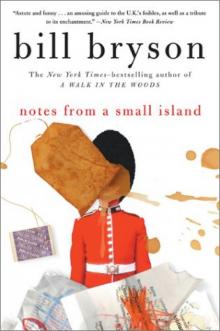 Notes from a Small Island
Notes from a Small Island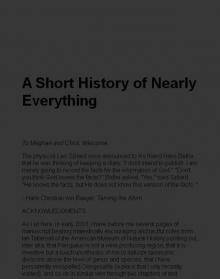 A Short History of Nearly Everything
A Short History of Nearly Everything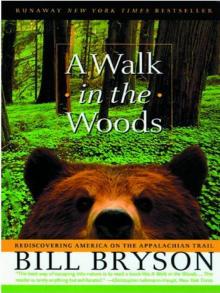 A Walk in the Woods
A Walk in the Woods I'm a Stranger Here Myself
I'm a Stranger Here Myself The Mother Tongue
The Mother Tongue Shakespeare
Shakespeare A Short History of Nearly Everything: Special Illustrated Edition
A Short History of Nearly Everything: Special Illustrated Edition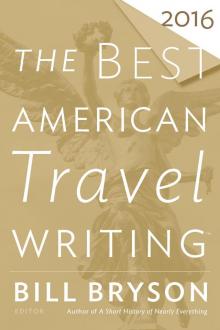 The Best American Travel Writing 2016
The Best American Travel Writing 2016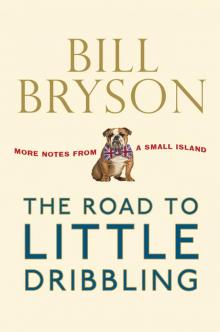 The Road to Little Dribbling
The Road to Little Dribbling The Life And Times Of The Thunderbolt Kid: A Memoir (v5.0)
The Life And Times Of The Thunderbolt Kid: A Memoir (v5.0) Made In America
Made In America Seeing Further
Seeing Further Shakespeare: The World as Stage
Shakespeare: The World as Stage The Life and Times of the Thunderbolt Kid
The Life and Times of the Thunderbolt Kid At Home
At Home Bryson's Dictionary For Writers And Editors (v5.0)
Bryson's Dictionary For Writers And Editors (v5.0) Neither Here Nor There
Neither Here Nor There Bill Bryson's African Diary
Bill Bryson's African Diary